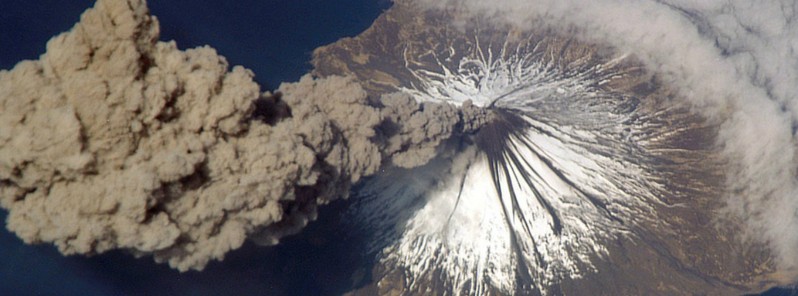Explosion at Cleveland volcano, alert levels raised

Mount Cleveland stratovolcano in Alaska erupted at 21:10 UTC on October 24, 2016, forcing the Alaska Volcano Observatory (AVO) to raise the color code/alert level from Yellow/Advisory to Orange/Watch.
The explosion was detected in both infrasound (air pressure) and seismic data, and was heard by residents in Nikolski 75 km (45 miles) from the volcano, AVO reported.
"However, no evidence of an eruption cloud is detected above the weather cloud deck height of 8.5 km (28 000 feet) and the summit is currently obscured by cloudy weather in web camera images."
Previous explosions at this volcano have typically produced ash emissions.
Cleveland is located on the uninhabited Chuginadak Island in the east-central Aleutians, its last eruption took place in May 2016.
Geological summary
Beautifully symmetrical Mount Cleveland stratovolcano is situated at the western end of the uninhabited, dumbbell-shaped Chuginadak Island. It lies SE across Carlisle Pass strait from Carlisle volcano and NE across Chuginadak Pass strait from Herbert volcano.
Cleveland is joined to the rest of Chuginadak Island by a low isthmus. The 1730-m-high Mount Cleveland is the highest of the Islands of the Four Mountains group and is one of the most active of the Aleutian Islands. The native name for Mount Cleveland, Chuginadak, refers to the Aleut goddess of fire, who was thought to reside on the volcano.
Numerous large lava flows descend the steep-sided flanks. It is possible that some 18th-to-19th century eruptions attributed to Carlisle should be ascribed to Cleveland (Miller et al., 1998).
In 1944 Cleveland produced the only known fatality from an Aleutian eruption. Recent eruptions have been characterized by short-lived explosive ash emissions, at times accompanied by lava fountaining and lava flows down the flanks. (GVP)
Featured image: Mount Cleveland eruption on May 23, 2006. Courtesy of Jeffrey N. Williams, Flight Engineer and NASA Science Officer, International Space Station Expedition 13 Crew, NASA Earth Observatory.

Commenting rules and guidelines
We value the thoughts and opinions of our readers and welcome healthy discussions on our website. In order to maintain a respectful and positive community, we ask that all commenters follow these rules:
We reserve the right to remove any comments that violate these rules. By commenting on our website, you agree to abide by these guidelines. Thank you for helping to create a positive and welcoming environment for all.